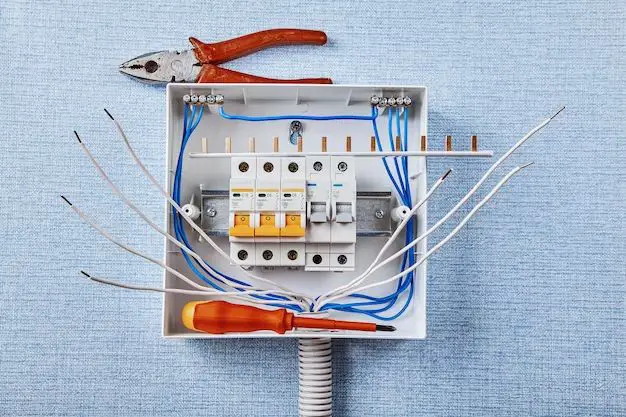Page Contents
Quick Answers
Breaker boxes, also known as electrical panels or load centers, house the circuit breakers that control and distribute electricity throughout a home. While some homeowners may wish to conceal breaker boxes behind walls, cabinets, or other coverings for aesthetic reasons, this is generally not recommended for safety and functionality. Some key points on whether a breaker box should be covered include:
- Electrical codes prohibit covering breaker boxes in most cases, as they need to be easily accessible in emergencies.
- Covering breaker boxes can lead to overheating issues, which is a fire hazard.
- Doing electrical work on a covered breaker box is more difficult and dangerous.
- Home inspectors and insurance companies may flag covered panels as problematic.
- The only exception is a cabinet designed specifically to house a breaker box, which allows easy access.
In summary, breaker boxes should almost always be left uncovered according to electrical codes and for safety reasons. Only in rare cases using a specialized cabinet would covering a panel be acceptable.
Should You Cover a Breaker Box?
Most electrical codes prohibit covering or obstructing breaker boxes in homes and businesses. This includes covering them with walls, cabinets, shelves, or any other materials. There are some good reasons why breaker boxes should generally remain uncovered:
Accessibility in Emergencies
First and foremost, covering a breaker box makes it much harder to quickly access the panel in an emergency. Breaker boxes contain circuit breakers that serve as the central shut off points for electricity throughout a building.
If there is an electrical fire or someone receives an electric shock, shutting off power at the breaker box is the quickest way to resolve the emergency. Even a few seconds delayed in accessing the panel could be life-threatening. Obstructing it with a cover could waste precious time.
Overheating Hazards
Electrical panels and the circuit breakers inside them generate a fair amount of heat during ordinary operation. Covering a breaker box can trap this heat, leading to overheating of the wiring and breakers inside the box. This builds up the risk of a fire hazard over time.
Circuit breakers and electrical wiring are designed to operate safely while openly exposed to air flow. Impeding airflow by covering a panel compromises this design, increasing the chances of overheating components.
Difficulty Doing Electrical Work
Beyond emergency access, a covered breaker box also makes it much more inconvenient and dangerous for electricians to work inside the panel for inspections, maintenance, or upgrades. Simple tasks like resetting tripped breakers or replacing old breakers become more difficult if the panel is obstructed.
Doing any wiring changes inside a covered panel would force electricians to work mostly blindly, increasing the risks of being shocked or causing accidental damage. Any time a home needs electrical work done, the breaker box will inevitably be involved, so covering it should be avoided.
Violations of Code
Most crucially, covering electrical panels violates electrical codes, such as the National Electrical Code (NEC) in the US. The NEC requires that breaker boxes be “readily accessible” in Section 110.26. Making panels difficult to access by covering them does not meet this code requirement.
Inspectors, whether for home sales/purchases or insurance purposes, may flag covered breaker boxes as problems to fix. Utility companies also need to access panels for maintenance of their metering equipment. Essentially, covered panels prevent legally required access.
When Can You Cover a Breaker Box?
There is one scenario in which a building code may permit a breaker box to be covered: installing a specially designed cabinet for the panel. These breaker box enclosures are made specifically to house a panel while still allowing easy access.
Here are some key things to know about breaker box cabinets:
- The cabinet doors must be easily removable or able to fully open at least 90 degrees.
- The interior space must meet minimum sizing requirements around the panel.
- Only certain fire-resistant and non-conductive materials are permitted.
- The panel interior must remain openly accessible to air flow.
As long as the cabinet meets the requirements, does not impede access to the breaker box, and allows airflow, installing this type of enclosure is legally permissible. The cabinet must also be clearly labeled as housing an electrical panel.
However, fully enclosing even specialty cabinets is often still avoided for optimal safety and accessibility. Leaving one side open or using vented doors is recommended. Only in rare cases would fully enclosing a panel in a cabinet make sense.
Conclusion
In summary, the answer to “should you cover a breaker box?” in most cases is a definite no. Electrical codes prohibit obstructing or covering panels to maintain emergency access. Doing so also risks overheating, makes any electrical work more difficult, and may violate code. The only exception would be enclosing a panel in a specialized cabinet designed specifically for breaker box access. Even then, some ventilation should be maintained. Keeping your home’s electrical panel fully open and accessible is the safest approach in nearly all situations.
| Can You Cover a Breaker Box With… | Recommended? |
|---|---|
| Wall | No |
| Cabinet | No |
| Shelving | No |
| Specialized breaker box cabinet | Yes, but not fully enclosed |
